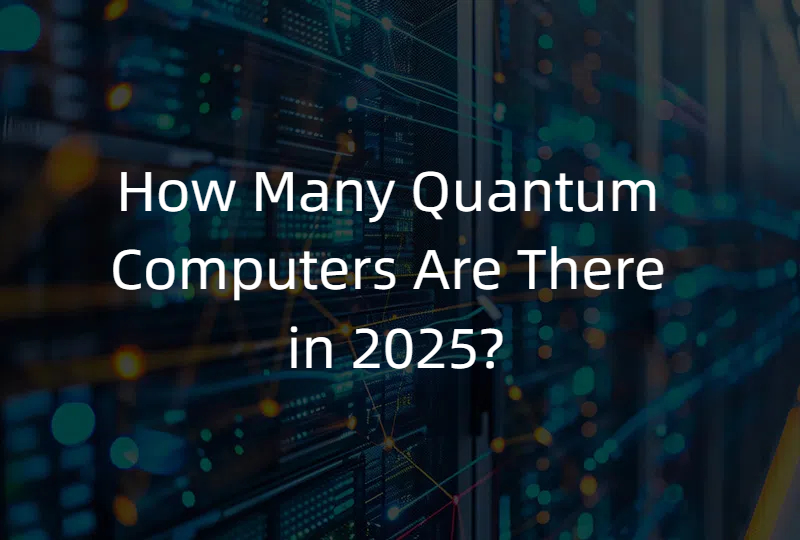Quantum Computing Education: The Complete Guide to Building Tomorrow's Quantum Workforce
2025.09.03 · Blog Quantum Computing Education
Quantum computing represents one of the most revolutionary technological advances of our time, promising to solve complex problems that are beyond the reach of classical computers. As we stand on the threshold of the quantum era, the need for comprehensive quantum computing education has never been more critical. The global quantum computing market, valued at approximately $1.3 billion in 2024, is projected to reach $5.3 billion by 2029, representing a robust compound annual growth rate (CAGR) of 32.7%.
The quantum education landscape is rapidly evolving, driven by government initiatives like the National Quantum Initiative Act and unprecedented industry demand. With only one qualified candidate existing for every three specialized quantum positions, the quantum talent shortage has become one of the most pressing challenges facing the industry. This comprehensive guide explores the complete quantum computing education ecosystem, from foundational concepts to advanced career pathways.
The Quantum Education Revolution

Quantum computing education is emerging as a vital trend that equips students, researchers, and professionals with the knowledge and skills to lead the quantum revolution. Unlike traditional computer science curricula that inadequately prepare students for quantum computing roles, specialized educational pathways address both theoretical foundations and practical applications.
Educational institutions worldwide are developing diverse quantum computing curricula targeting different levels, from K-12 quantum concepts to graduate-level specializations. The emergence of hands-on quantum education using real quantum systems, rather than relying solely on classical simulations, represents perhaps the most innovative development in quantum courses.
Fundamentals of Quantum Computing
Core Quantum Concepts
Understanding quantum computing begins with grasping fundamental quantum mechanical principles that distinguish quantum systems from classical computers. Superposition allows qubits to exist in multiple states simultaneously, enabling exponentially more powerful computations for specific types of problems. Entanglement creates correlations between qubits that classical systems cannot replicate, while quantum interference enables quantum algorithms to amplify correct answers and cancel out incorrect ones.
Mathematical Foundations
Quantum algorithms rely heavily on several mathematical disciplines that form the backbone of quantum education:
-
Linear Algebra: Essential for representing quantum states, quantum gates, and unitary transformations
-
Probability Theory: Used to understand quantum measurements and probabilistic outcomes
-
Complex Numbers: Fundamental for expressing quantum states and wave functions
-
Fourier Analysis: Applied in algorithms like Quantum Fourier Transform (QFT)
-
Group Theory: Relevant for quantum error correction and symmetry-based computations
Quantum Programming Languages
Most quantum programming frameworks are built on Python, making it the dominant language for quantum computing development. Key frameworks include:
-
Qiskit (IBM): Python-based, supports quantum circuit design, simulation, and real hardware execution
-
Cirq (Google): Focuses on near-term quantum algorithms and hardware-specific control
-
SpinQit (SpinQ): Python-based with compatibility for OpenQASM 2.0 and Qiskit syntax
-
PennyLane (Xanadu): Integrates quantum computing with machine learning workflows
Educational Pathways and Programs
K-12 Quantum Education: Breaking New Ground
The implementation of quantum computing curricula in high schools represents a groundbreaking development in STEM education. SpinQ Technology has pioneered this approach, successfully implementing quantum computing curricula in institutions like Shenzhen Gezhi Academy and Guilin Shoufu Experimental Middle School. These programs demonstrate that quantum concepts can be effectively taught to secondary students when supported by appropriate hardware and curriculum design.
K-12 quantum courses typically focus on:
-
Basic quantum gates and circuits through interactive visualizations
-
Foundational algorithms like Deutsch's and Grover's to demonstrate quantum speedup
-
Introductory concepts of qubits, superposition, and entanglement
University Programs: Building Deep Expertise
Universities worldwide have developed comprehensive quantum computing curricula targeting different educational levels. Undergraduate programs typically introduce quantum concepts through modified physics and computer science courses, emphasizing mathematical foundations and basic quantum algorithms. These programs often utilize simulation environments and cloud-based quantum access to provide hands-on experience.
Leading University Programs:
| Institution | Program | Duration | Focus Area |
|---|---|---|---|
| Harvard University | PhD in Quantum Science and Engineering | 4-5 years | Research and teaching |
| University of Maryland | Master of Science in Quantum Computing | 2 years | 30-credit non-thesis program |
| University of Pittsburgh | Bachelor's in Physics and Quantum Computing | 4 years | Specialization options |
| MIT | Quantum Computing for Engineers | Variable | Circuits and hardware |
| Stanford | Quantum Computing Program | Variable | Algorithms and ML applications |
Online Learning Revolution
The proliferation of online quantum computing courses has democratized access to quantum education. Major platforms include:
Industry-Sponsored Programs:
-
IBM Qiskit Global Summer School: Attracts thousands of participants annually with intensive quantum programming training
-
Microsoft Azure Quantum: Comprehensive training modules covering quantum development environments
-
Google Quantum AI: Educational resources using Cirq framework
University Online Courses:
-
MIT xPRO Quantum Computing Fundamentals: Two-course program targeting professionals ($2,500)
-
University of Toronto (Coursera): Quantum Machine Learning specialization
-
UC Berkeley (edX): Quantum Mechanics and Computation
-
Caltech: Quantum Algorithms for Scientific Computing
Quantum Algorithms and Applications
Fundamental Quantum Algorithms
Understanding quantum algorithms is crucial for quantum computing education, as they demonstrate the practical advantages of quantum systems over classical computers.
Shor's Algorithm: Developed by Peter Shor in 1994, this algorithm revolutionizes cryptography by factoring large numbers exponentially faster than classical algorithms. Shor's algorithm threatens current encryption methods like RSA, leading to the development of quantum-resistant cryptography.
Grover's Algorithm: Introduced by Lov Grover in 1996, this algorithm provides quadratic speedup for unstructured search problems, reducing search time from O(N) to O(√N). While not exponential, Grover's algorithm offers significant advantages for database queries, machine learning, and pattern recognition.
Quantum Fourier Transform (QFT): QFT serves as a quantum analog of the classical Fourier transform and forms the foundation of many quantum algorithms, including Shor's algorithm and phase estimation. It enables efficient processing of quantum data and is invaluable in quantum chemistry and physics simulations.
NISQ-Era Applications
Current quantum computers operate in the Noisy Intermediate-Scale Quantum (NISQ) era, featuring devices with 50-1,000 qubits that are advanced enough for real-world applications but lack comprehensive quantum error correction.
Variational Quantum Algorithms (VQAs) represent the most promising approach for NISQ devices, combining quantum processing with classical optimization:
-
Variational Quantum Eigensolver (VQE): Finds ground state energy of quantum systems, crucial for quantum chemistry and drug discovery
-
Quantum Approximate Optimization Algorithm (QAOA): Designed for optimization problems in logistics, finance, and scheduling
Hardware and Software Ecosystem
Quantum Hardware Platforms
Understanding different quantum hardware approaches is essential for comprehensive quantum education. Major quantum computing platforms include:
Superconducting Qubits:
-
IBM Quantum: Systems ranging from 5 to 127 qubits with strong academic integration
-
Google Quantum AI: Sycamore and Willow processors demonstrating quantum supremacy
Ion Trap Systems:
-
IonQ: High-fidelity trapped-ion qubits with long coherence times
-
Quantinuum: Advanced trapped-ion platforms for fault-tolerant research
Educational Hardware:
-
SpinQ Systems: Educational quantum computers like Gemini Mini and Triangulum operating at room temperature
Cloud Quantum Platforms
Quantum-as-a-Service (QaaS) models make quantum computing accessible without massive capital investments:
| Platform | Qubit Types | Access Model | Key Features |
|---|---|---|---|
| IBM Quantum | Superconducting | Free tier + premium | 5-127 qubits, Qiskit integration |
| Amazon Braket | Multiple vendors | Pay-per-shot | Multi-platform support |
| Microsoft Azure | Various partners | Hybrid workflows | Enterprise focus |
| SpinQ Cloud | NMR + Superconducting | Educational focus | Global access, multilingual |
Career Opportunities and Market Demand
Explosive Job Market Growth
The quantum computing job market is experiencing unprecedented growth, with demand increasing 25% annually in the United States. Analysts expect 5,000-7,000 additional quantum jobs to be created by 2027, driven by government initiatives and private sector adoption.
Skills in High Demand
Employers seek candidates with interdisciplinary skills combining:
-
Technical Skills: Python programming, linear algebra, quantum mechanics
-
Quantum Frameworks: Qiskit, Cirq, SpinQit proficiency
-
Mathematical Foundation: Complex analysis, probability theory, optimization
-
Domain Knowledge: Industry-specific applications and problem-solving
Challenges and Future Directions
Current Educational Challenges
Quantum computing education faces several significant challenges:
Technical Barriers:
-
Hardware Complexity: Quantum systems require sophisticated control and isolation
-
Error Rates: Current NISQ devices are prone to decoherence and noise
-
Scalability: Building large, fault-tolerant systems remains technically demanding
Educational Barriers:
-
Instructor Shortage: Limited number of qualified quantum computing educators
-
Curriculum Development: Need for standardized, scalable educational content
-
Access to Hardware: Limited availability of hands-on quantum systems for education
Emerging Solutions
The quantum education community is developing innovative solutions:
Hardware-Integrated Learning: Companies like SpinQ are developing educational quantum computers that operate at room temperature, making hands-on quantum experience accessible to schools and universities.
Teacher Training Programs: Comprehensive professional development programs combine theoretical knowledge with hands-on hardware experience and quantum-specific pedagogical techniques.
Modular Curriculum Systems: Adaptive educational content that scales across different institutions and educational levels, from high school introductions to university research programs.
Future Outlook: The Next Decade
The next decade promises significant developments in quantum computing and education:
Technological Advancement:
-
Fault-Tolerant Systems: Transition from NISQ to error-corrected quantum computers
-
Increased Qubit Counts: Systems targeting thousands of qubits within the next few years
-
Improved Error Rates: Advancing toward the quantum threshold for fault tolerance
Market Maturation: The quantum computing industry will likely transition from research-focused activities to commercial applications, creating clearer career paths and revenue opportunities. Government support through initiatives like the National Quantum Initiative will continue driving growth and creating opportunities.
Educational Integration: Quantum computing concepts will become increasingly integrated into mainstream STEM education, similar to how computer science evolved from a specialized field to a foundational skill.
Getting Started: Your Quantum Education Journey
For Students
-
Build Mathematical Foundations: Master linear algebra, probability theory, and complex numbers
-
Learn Python Programming: Essential for quantum frameworks like Qiskit and Cirq
-
Start with Online Courses: Explore IBM Quantum Learning, MIT xPRO, or university MOOCs
-
Gain Hands-On Experience: Use cloud quantum platforms for practical learning
-
Join Communities: Participate in quantum computing forums, hackathons, and conferences
For Educators
-
Develop Quantum Literacy: Understand fundamental concepts and current applications
-
Explore Educational Hardware: Consider room-temperature quantum systems for classrooms
-
Create Modular Curricula: Design adaptable content for different educational levels
-
Connect with Industry: Partner with quantum companies for real-world perspectives
-
Participate in Professional Development: Attend quantum education workshops and training
For Professionals
-
Assess Transfer Skills: Identify how current expertise applies to quantum computing
-
Choose Specialization: Focus on quantum algorithms, hardware, or applications
-
Pursue Formal Education: Consider graduate programs or professional certificates
-
Build Portfolio Projects: Demonstrate quantum programming skills through practical projects
-
Network Actively: Connect with quantum professionals and join industry organizations
Conclusion: Building the Quantum Future
Quantum computing education stands at the forefront of a technological revolution that promises to reshape industries and solve humanity's most complex challenges. From K-12 introductions that spark curiosity to advanced graduate programs preparing quantum researchers, the educational ecosystem is rapidly evolving to meet unprecedented industry demand.
The convergence of government support, industry investment, and educational innovation creates an unparalleled opportunity for students and professionals to enter this transformative field. With over $10 billion in public sector quantum investments expected in the coming years and a projected market value of $97 billion by 2035, quantum computing education represents both a strategic imperative and an extraordinary career opportunity.
As we advance toward fault-tolerant quantum systems and practical quantum applications, the importance of comprehensive quantum education cannot be overstated. The students and professionals who invest in quantum computing education today will become the architects of tomorrow's quantum-powered world, solving problems in drug discovery, climate modeling, financial optimization, and cybersecurity that are currently beyond our reach.
The quantum education revolution is not just about preparing for the future—it is about creating it. Through innovative curricula, hands-on hardware experiences, and interdisciplinary collaboration, quantum computing education is building the foundation for a quantum-literate society capable of harnessing the full potential of quantum technologies.
Whether you are a student exploring quantum concepts for the first time, an educator developing quantum curricula, or a professional transitioning into quantum computing, the journey begins with education. The quantum future awaits those prepared to embrace its possibilities and master its principles.
Featured Content






